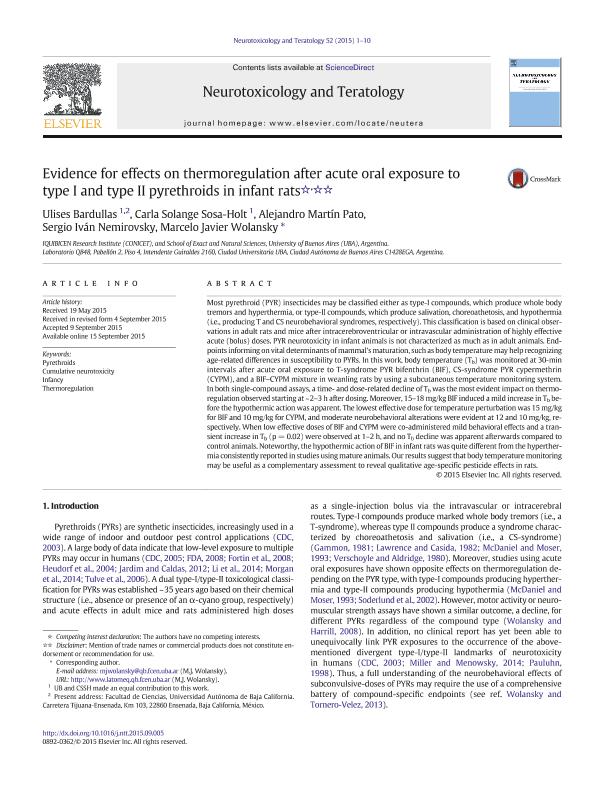Artículo
Evidence for effects on thermoregulation after acute oral exposure to type I and type II pyrethroids in infant rats
Bardullas, Ulises; Sosa Holt, Carla Solange ; Pato, Alejandro Martin; Nemirovsky, Sergio Ivan
; Pato, Alejandro Martin; Nemirovsky, Sergio Ivan ; Wolansky, Marcelo Javier
; Wolansky, Marcelo Javier
 ; Pato, Alejandro Martin; Nemirovsky, Sergio Ivan
; Pato, Alejandro Martin; Nemirovsky, Sergio Ivan ; Wolansky, Marcelo Javier
; Wolansky, Marcelo Javier
Fecha de publicación:
11/2015
Editorial:
Pergamon-Elsevier Science Ltd
Revista:
Neurotoxicology and Teratology
ISSN:
0892-0362
Idioma:
Inglés
Tipo de recurso:
Artículo publicado
Clasificación temática:
Resumen
Most pyrethroid (PYR) insecticides may be classified either as type-I compounds, which produce whole body tremors and hyperthermia, or type-II compounds, which produce salivation, choreoathetosis, and hypothermia (i.e., producing T and CS neurobehavioral syndromes, respectively). This classification is based on clinical observations in adult rats and mice after intracerebroventricular or intravascular administration of highly effective acute (bolus) doses. PYR neurotoxicity in infant animals is not characterized as much as in adult animals. Endpoints informing on vital determinants ofmammal'smaturation, such as body temperature may help recognizing age-related differences in susceptibility to PYRs. In this work, body temperature (Tb) was monitored at 30-min intervals after acute oral exposure to T-syndrome PYR bifenthrin (BIF), CS-syndrome PYR cypermethrin (CYPM), and a BIF?CYPM mixture in weanling rats by using a subcutaneous temperature monitoring system. In both single-compound assays, a time- and dose-related decline of TTb was the most evident impact on thermoregulation observed starting at ~2-3 h after dosing. Moreover, 15-18 mg/kg BIF induced a mild increase in TTb before the hypothermic action was apparent. The lowest effective dose for temperature perturbationwas 15 mg/kg for BIF and 10 mg/kg for CYPM, and moderate neurobehavioral alterations were evident at 12 and 10 mg/kg, respectively. When low effective doses of BIF and CYPM were co-administered mild behavioral effects and a transient increase in TTb (p=0.02) were observed at 1-2 h, and no Tb decline was apparent afterwards compared to control animals. Noteworthy, the hypothermic action of BIF in infant ratswas quite different from the hyperthermia consistently reported in studies usingmature animals. Our results suggest that body temperaturemonitoring may be useful as a complementary assessment to reveal qualitative age-specific pesticide effects in rats.
Palabras clave:
CUMULATIVE NEUROTOXICITY
,
INFANCY
,
PYRETHROIDS
,
THERMOREGULATION
Archivos asociados
Licencia
Identificadores
Colecciones
Articulos(IQUIBICEN)
Articulos de INSTITUTO DE QUIMICA BIOLOGICA DE LA FACULTAD DE CS. EXACTAS Y NATURALES
Articulos de INSTITUTO DE QUIMICA BIOLOGICA DE LA FACULTAD DE CS. EXACTAS Y NATURALES
Citación
Bardullas, Ulises; Sosa Holt, Carla Solange; Pato, Alejandro Martin; Nemirovsky, Sergio Ivan; Wolansky, Marcelo Javier; Evidence for effects on thermoregulation after acute oral exposure to type I and type II pyrethroids in infant rats; Pergamon-Elsevier Science Ltd; Neurotoxicology and Teratology; 52; 11-2015; 1-10
Compartir
Altmétricas



